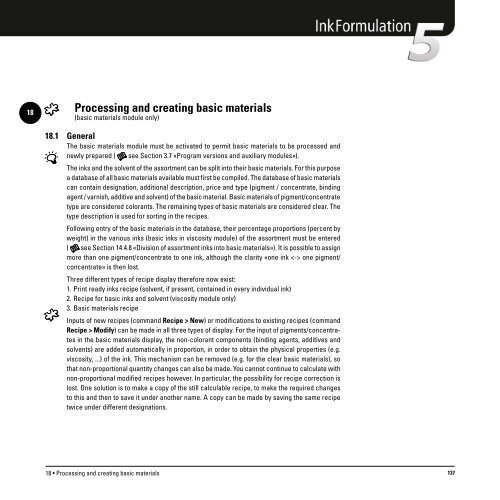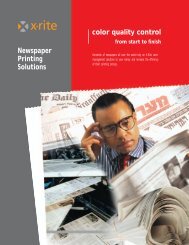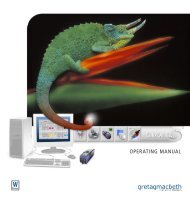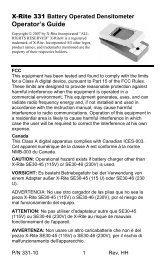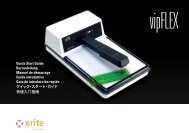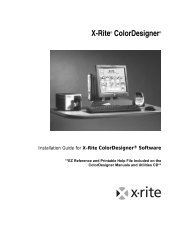Operating Manual
Operating Manual
Operating Manual
Create successful ePaper yourself
Turn your PDF publications into a flip-book with our unique Google optimized e-Paper software.
18<br />
Processing and creating basic materials<br />
(basic materials module only)<br />
18.1 General<br />
The basic materials module must be activated to permit basic materials to be processed and<br />
newly prepared ( see Section 3.7 «Program versions and auxiliary modules»).<br />
The inks and the solvent of the assortment can be split into their basic materials. For this purpose<br />
a database of all basic materials available must first be compiled. The database of basic materials<br />
can contain designation, additional description, price and type (pigment / concentrate, binding<br />
agent / varnish, additive and solvent) of the basic material. Basic materials of pigment/concentrate<br />
type are considered colorants. The remaining types of basic materials are considered clear. The<br />
type description is used for sorting in the recipes.<br />
Following entry of the basic materials in the database, their percentage proportions (percent by<br />
weight) in the various inks (basic inks in viscosity module) of the assortment must be entered<br />
( see Section 14.4.8 «Division of assortment inks into basic materials»). It is possible to assign<br />
more than one pigment/concentrate to one ink, although the clarity «one ink one pigment/<br />
concentrate» is then lost.<br />
Three different types of recipe display therefore now exist:<br />
1. Print ready inks recipe (solvent, if present, contained in every individual ink)<br />
2. Recipe for basic inks and solvent (viscosity module only)<br />
3. Basic materials recipe<br />
Inputs of new recipes (command Recipe > New) or modifications to existing recipes (command<br />
Recipe > Modify) can be made in all three types of display. For the input of pigments/concentrates<br />
in the basic materials display, the non-colorant components (binding agents, additives and<br />
solvents) are added automatically in proportion, in order to obtain the physical properties (e.g.<br />
viscosity, ...) of the ink. This mechanism can be removed (e.g. for the clear basic materials), so<br />
that non-proportional quantity changes can also be made. You cannot continue to calculate with<br />
non-proportional modified recipes however. In particular, the possibility for recipe correction is<br />
lost. One solution is to make a copy of the still calculable recipe, to make the required changes<br />
to this and then to save it under another name. A copy can be made by saving the same recipe<br />
twice under different designations.<br />
18 • Processing and creating basic materials 137


